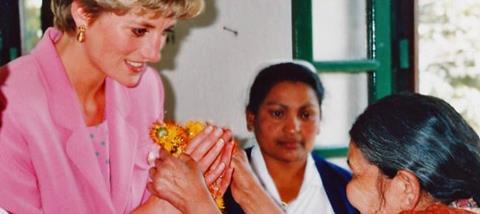
In November 1989 the headline in The Sun newspaper screamed out 'Di to Shake Hands with Leper, Don't Do It Di'.
Princess Diana wasn't afraid of making a splash. Completely against the advice of her legal advisors she had touched - with her bare hands - a leprosy patient at Sitanala Leprosy Hospital in Indonesia.
Practically there was little risk to the late Princess of Wales's health. Leprosy is a mildly-infectious and completely curable disease. In fact a person is thought to need to live in ultra-poor conditions with someone with untreated leprosy for months in order to contract the deeply-disabling disease.
But this was no ordinary woman and no straight-forward disease. We are talking about the then most photographed woman in the world. And leprosy is the world's oldest and most stigmatised disease.
I was speaking to Hugh Whittow, editor of the Daily Express, this week who was in the press pack at Sitanala Hospital while working for the Daily Star in 1989. The seasoned hack was deeply touched by the plight of people affected by leprosy, recounting that the experience has never left him.
He added that he was appalled to learn of The Sun's headline on his return from Indonesia.
But for us at The Leprosy Mission and for leprosy-patients across the globe, this story was actually a God-send!
Overlooking the awfully outdated and derogatory label 'leper', there on the front page of the tabloids was Diana reaching out to the world's most marginalised people. These are people that even the beggars on the street pleading for their next meal will shun. If you have leprosy you're often treated as the lowest of the low.
Soon after these events, Diana became Patron of The Leprosy Mission and made visits to Premanda Hospital in Kolkata, India, and Anandaban Hospital in Nepal. Even when she reduced her patronage of nearly 100 charities to just six in 1996, she chose to continue her support of The Leprosy Mission until the day she died, 20 years ago today.
Staff working at the hospitals say these visits had an unquantifiable ripple effect. By the simple act of holding someone’s hand she showed to the world that leprosy was not a disease to be feared. For people who were scared they had leprosy but could not face the shame of going to a leprosy hospital, suddenly it was okay. After all it can't be that bad a place - an English princess had been there!
Diana's empathy with leprosy patients and very public support of The Leprosy Mission coincided with a worldwide effort to eliminate leprosy as a public health problem by 2000. This was measured by a target of governments recording less than one in 10,000 people being treated for leprosy.
This global target was achieved, but it created a false sense of success. When the numbers fell below the one in 10,000 rate, governments put money into other emerging health problems like HIV instead.
It is not by chance that Diana's death coincided with a general apathy towards leprosy and a public perception that the Biblical disease had finally been 'dealt with'. Tragically we still mourn the 'Diana effect' with the latest research revealing millions of new leprosy cases are going undiagnosed. I'm certain that should her life had not been cut tragically short and she had continued campaigning, the world would be closer to ridding itself of this cruel disease.
In the meantime the number of new cases where people have already developed an irreversible disability is rising. This demonstrates the desperate need to diagnose and treat sooner, something our staff across Asia and Africa work tirelessly to achieve.
At The Leprosy Mission we praise God for the work one extraordinary woman started. And we long for the 'Diana effect' to ripple further into the remotest and most shunned communities across the globe.
Charlotte Walker works for the The Leprosy Mission. For more information visit leprosymission.org.uk




























